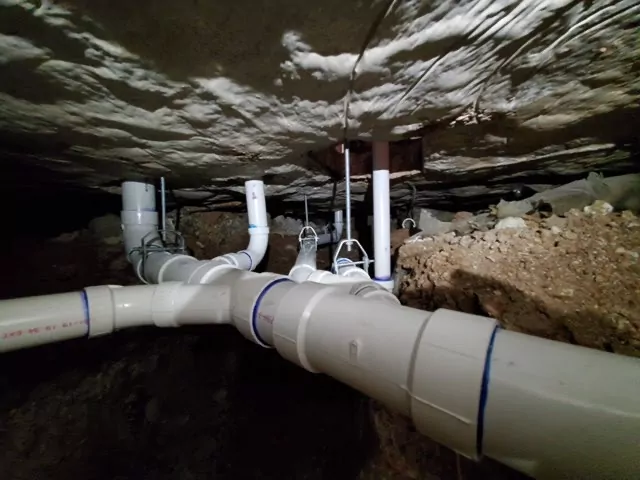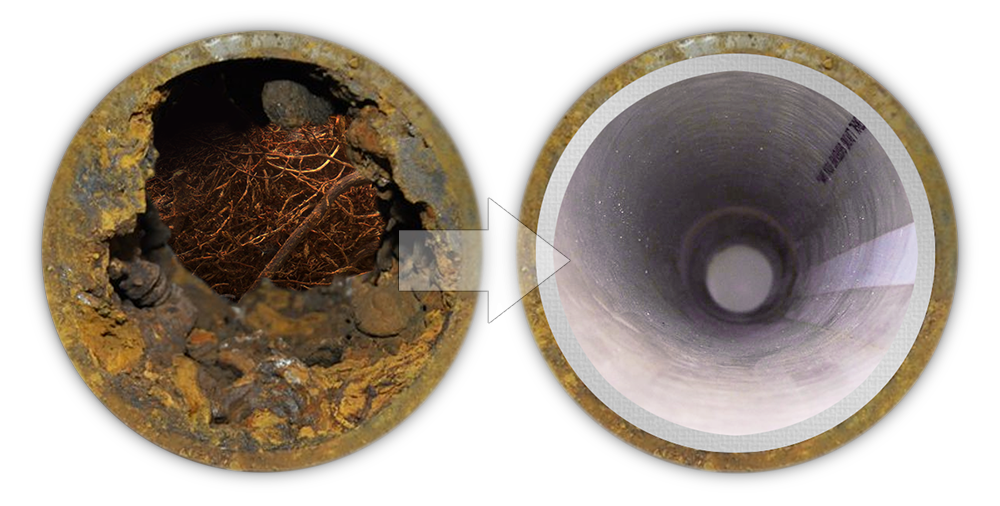What Damages Are Caused In A Home That Has To Be Excavated To Replace Old Pipes Underground?

Homes built before 1972 all have cast iron sewer pipes. Over time, most of the corrosion occurs along the bottom which creates a wide crack. Excavating floors to replace old cast iron pipes with new PVC can be a major undertaking that can result in significant damage to a home. In this article, we will explore the types of damage that can occur and what homeowners can expect during the process.
First, let’s consider why homeowners may need to replace old cast iron pipes. Cast iron pipes have been used for many years in sewage and drainage systems, but over time they can become corroded and weakened, leading to leaks, backups, and other problems. Replacing these pipes with new PVC pipes can help prevent further damage and ensure that the plumbing system functions properly.
However, replacing old cast iron pipes often requires excavating the floors of a home. This can be a major undertaking that can result in a significant amount of damage.
Here are some of the types of damage that homeowners may experience during the process:
- Flooring Damage: Excavating floors can result in significant damage to flooring materials such as tile, hardwood, and carpeting. In some cases, entire sections of flooring may need to be removed to allow for access to the pipes.
- Wall Damage: Excavation work can also damage walls, particularly if the pipes run through interior walls. Walls may need to be cut or removed to allow for access to the pipes.
- Structural Damage: Excavating floors can also cause structural damage to a home. If load-bearing walls are affected, additional support may need to be added to ensure that the structure remains stable.
- Dust and Debris: Excavation work can also create a significant amount of dust and debris, which can spread throughout the home and cause respiratory issues or exacerbate existing allergies or respiratory conditions.
While the damage caused by excavating floors to replace old cast iron pipes can be significant, it’s important to remember that this process is often necessary to ensure the long-term health and safety of a home. Working with a licensed and experienced plumber can help minimize the damage and ensure that the work is completed as efficiently and effectively as possible.
In conclusion, replacing old cast iron pipes with new PVC can be a major undertaking that can result in significant damage to a home. However, by understanding what types of damage can occur and working with a licensed and experienced plumber, homeowners can minimize the damage and ensure that the plumbing system is functioning properly for years to come.
Digging a trench or tunnel underneath a home to replace old pipes can be a bad idea for several reasons:
Damage to the home’s foundation: Digging a trench or tunnel underneath a home can cause damage to the foundation, which can lead to structural issues and costly repairs.
Disruption of landscaping: Trenching or tunneling can also disrupt landscaping and cause damage to trees, plants, and other outdoor features, which can be expensive and time-consuming to replace.
Safety hazards: Digging a trench or tunnel can be hazardous, especially if proper safety precautions are not taken. This can include risks associated with cave-ins, heavy machinery, and excavation equipment.
Disruption to daily life: Trenching or tunneling can be a noisy and disruptive process, which can be especially challenging if the work is being done near residential areas or during normal business hours.
Cost: Digging a trench or tunnel can be an expensive process, especially if it requires special equipment or the removal of large amounts of soil or rock.


The Solution
Since 2004, we have been relining the inside of these pipes with patented pipe restoration technology, which typically takes 3-4 days, costs 50% less than excavation, and tenants can stay home and use the plumbing 20 hours per day! We save about 400 homes per year, plus many high-rise buildings, restaurants etc. We make final video recordings of the pipes when done. See thousands of them here.
MUST WATCH! How Does It Work
From outside your property, we open the pipe, clean out the rust, scale, and roots, and then install a new “pipe liner” or sleeve which has been saturated with a self-hardening epoxy resin. The liner contains a balloon that is inflated for 3 hours while the resin becomes rock-hard. Then the balloon is removed. Alternatively, a robotic machine drives through the pipes, under camera supervision, and applies the epoxy resin to the inside of the pipe.
Our Two Technologies
We are certified Perma-Liner and Picote installers, the two widely approved technologies in the US. The latter has been in use since 2017, and the former since 1998. We often use both technologies on the same property, depending on pipe conditions. Either way, we offer a 50-year, transferable, warranty.

Very Safe - Highly Regulated Industry
The materials used in this industry are highly regulated by US and international authorities since it is used in the food industry and is used for rainwater run-off that enters rivers, lakes etc. that contain wildlife and provide a source of our potable water.
About Our 50-Year, Transferable, Warranty
Our 50-year warranty is based on tests done by independent materials testing companies, like HTS in Houston, which determine the minimum “engineered life” after measuring the flexural modulus, elongation modulus, tensile strength etc. It is transferable to new homeowners later. It also guarantees you will never have backups again!


Real Estate Transaction On Hold?
About 34% of our work involves homes for sale that have had their sewer pipes inspected and the inspector recommends that the pipes should be replaced by excavation through the floor. Suddenly the sale is put on hold whilst the buyers decide what they should do!
Our Solution
Our estimator can perform a video inspection to determine how many feet of pipe need to be lined and if there are any reasons why some of the pipes cannot be lined. We then provide a firm quote for pipe lining that the buyer and seller can incorporate into their negotiations!
Before And After Video Of Cast Iron Pipe With Many Holes, After Spin Cast Lining
We try to use spin-cast lining as much as possible due to its multiple benefits, zero risk of anything going wrong during installation, 100% pipe coverage, and least amount of pipe downtime.
Commercial Pipe Lining For High Rise Buildings, Restarurants and Factories etc.
Businesses in Florida have cast iron drains that have been rusting and scaling up for decades. Eventually the pipe will crack along the bottom or completely rust away on the floor, causing repeated backups. The old school plumber will suggest concrete excavation and pipe replacement, which is very expensive, time consuming, messy, and will cost the business cast amounts of downtime expenses!
However, our Cured In Place Pipe (CIPP) or Spin-Cast Lining installs in 1-4 hours. The lining is a tough, inert inner pipe that reduces diameter by only 5%, and the old pipe outside can disintegrate since the lining is a stand-alone, load-bearing pipe by itself!


High-Rise Buildings
The vertical sewer lines/drains (“stacks”) in tall buildings also form a crack along the length of the pipe when the corrosion eventually makes its way through the pipe. These stacks are often behind kitchen cabinets, encased in concrete walls etc., and so replacing them can be very time-consuming and expensive ($250-$300 per linear foot in South Florida).
Our pipe lining technology installs from the rooftop and so we never need to enter any of the premises. Also, pipe downtime is only 4 hours power stack, and costs about $150 per foot (varies by project size).
Our Technology, As Featured On An Episode Of "Designing Spaces" !
This professionally-produced video features a family who just purchased their home and experienced backups right away. After snaking the pipes several times, their plumber used a video camera to diagnose the problem. Their cast-iron pipes had rough scale and “channeling” (cracked floor of pipe) which were trapping the debris. He recommended replacing the pipes through excavation. But instead, the homeowners used our technology (C.I.P.P in this case) to save their home, ad 50% of the cost!
